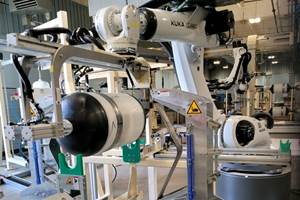American wind energy adds jobs in 2014, credits PTC tax credit
The industry calls on Congress to extend the Production Tax Credit (PTC) for wind power.
The U.S. wind industry added 23,000 jobs in 2014, boosting the sector’s total to 73,000 jobs. This year began with 12,700 MW of wind projects under construction, a record for the start of any year, according to the American Wind Energy Association (AWEA, Washington, DC, US) in its U.S. Wind Industry Annual Market Report.
Tom Kiernan, CEO of AWEA, said that the results show that extending the Production Tax Credit (PTC) for wind power in 2013 was good for business. There was four times more new wind power generating capacity online last year than in 2013. The 2013 wind deployment was down 92% from 2012 levels because of policy uncertainty caused by the brief lapse of the PTC at the end of 2012. That lapse resulted in the loss of 30,000 wind industry jobs in America.
The PTC expired in 2014 and the wind industry is asking Congress to revive it, however, a majority of the Senate went on record against a five-year extension of the PTC this past January. While President Obama’s proposed 2016 budget would permanently extend the PTC, it is unclear if Congress will approve it.
In the U.S. wind manufacturing sector specifically, wind now employs nearly 20,000 workers in more than 500 facilities across 43 states, in addition to 53,000 other jobs in project development, construction, operations, and other parts of the industry. The U.S. wind industry drove $12 billion in private investment last year, for a total of more than $100 billion since 2008.
“The PTC enabled the private sector to make critical investments in domestic manufacturing and the American workforce, driving significant cost reductions. That has driven technology improvements and cost reductions that are creating a modern day ‘wind rush’ by opening up new areas for development,” said AWEA Deputy Director of Industry Data and Analysis Emily Williams. “We have utility scale turbines operating in 39 states today, and if these trends continue and stable policy is in place, we can see wind deployment in even more states.”
A U.S. Department of Energy report released last month shows that wind energy can double within the next five years to supply 10 percent of U.S. electricity by 2020, 20 percent by 2030, and 35 percent by 2050.
Strong activity in Texas
The U.S. “wind rush” is at its height in Texas, with 7,500 MW of wind projects currently under construction, more than all other states combined. The wind industry invested $3 billion in Texas last year, bringing total cumulative investment to over $26 billion.
The completion of the Competitive Renewable Energy Zone (CREZ) transmission lines a year ago has played a critical role in opening up Texas’s wind resources to development. That success will soon be replicated in other parts of the Plains and the Midwest, which are following suit with major new transmission upgrades.
The Texas wind boom resulted in the addition of 9,000 jobs in 2014, bringing Texas to a U.S.leading 17,000 wind industry jobs. Rounding out the top five states with the most wind industry jobs are Iowa and Colorado with over 6,000 jobs each, Oklahoma with nearly 5,000 jobs, and Michigan with over 3,000 jobs.
Ohio again ranks number one in wind manufacturing facilities, while Colorado and then Iowa lead with the most manufacturing jobs.
Related Content
Zeiss, Imperial College London summer school enhances materials, sustainability learning
Twenty-four next-generation students attended the Imperial College London this August to advance their scientific knowledge, with workshops, lectures, activities and a composites competition.
Read MoreASCEND program update: Designing next-gen, high-rate auto and aerospace composites
GKN Aerospace, McLaren Automotive and U.K.-based partners share goals and progress aiming at high-rate, Industry 4.0-enabled, sustainable materials and processes.
Read MoreAutomated filament winding system increases throughput, reduces manual labor for pressurized well tank production
For its new line of composite well water tanks, Amtrol worked with Roth Composite Machinery on an automated process for faster, more easily tracked production.
Read MoreMaterials & Processes: Fabrication methods
There are numerous methods for fabricating composite components. Selection of a method for a particular part, therefore, will depend on the materials, the part design and end-use or application. Here's a guide to selection.
Read MoreRead Next
Composites end markets: Energy (2024)
Composites are used widely in oil/gas, wind and other renewable energy applications. Despite market challenges, growth potential and innovation for composites continue.
Read MoreCW’s 2024 Top Shops survey offers new approach to benchmarking
Respondents that complete the survey by April 30, 2024, have the chance to be recognized as an honoree.
Read MoreFrom the CW Archives: The tale of the thermoplastic cryotank
In 2006, guest columnist Bob Hartunian related the story of his efforts two decades prior, while at McDonnell Douglas, to develop a thermoplastic composite crytank for hydrogen storage. He learned a lot of lessons.
Read More













.jpg;maxWidth=300;quality=90)











